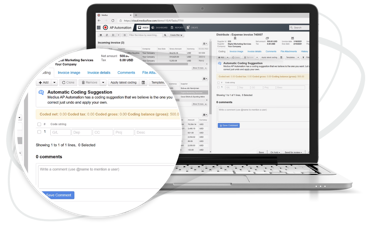 Dynamic adaptability and continuous learning
Dynamic adaptability and continuous learning
AI-powered autonomous systems have the incredible ability to learn and adapt dynamically. By analyzing historical data and identifying patterns, machine learning algorithms can adjust approval workflows and processing rules in real-time. This iterative learning process ensures the system becomes more efficient and effective as it encounters new scenarios without requiring frequent manual adjustments. This kind of adaptability enables a more flexible and responsive accounts payable process, making everyone's lives a little easier – from the accounts payable team to the IT team to the CFO.
 Unstructured data handling
Unstructured data handling
AI, especially NLP, is great at understanding and interpreting unstructured data. This means autonomous systems can extract valuable information from all kinds of complex sources, making data more accurate and complete.
Intelligent Document Processing (IDP) is a tool that transforms unstructured or semi-structured data into structured and usable information. With IDP, AP teams can leverage invoice scanning tools to pull information into structured data for analysis.
Optical Character Recognition (OCR) extracts text from paper documents and is a superpower when combined with IDP. These AI technologies can create detailed info from unstructured data, giving insights into payment timing and eliminating mistakes like double payments. This data also acts as a benchmarking tool, showing which invoice payment processes need refining. Without human intervention, these powerful tools go beyond simple automation to autonomous AP.
 Intelligent invoice processing
Intelligent invoice processing
AI can effortlessly handle unstructured data, diverse formats and multiple languages, which boosts the accuracy and efficiency of your invoice processing system. Automated e-invoicing systems and data extraction and verification significantly reduce data entry errors and minimize overpayments, duplicate payments and other costly mistakes. This enables straight-through invoice processing and true autonomous accounts payable.
 Predictive analytics
Predictive analytics
AI-powered autonomous systems use predictive analytics to anticipate cash flow, detect payment trends and proactively address potential concerns. Leveraging AI-backed technology helps you achieve more accurate and timely cash forecasting. Liabilities are instantly recorded and measurable, enabling real-time and precise cash forecasting. This empowers organizations to enhance liquidity management and optimize working capital. A proactive approach like this helps make informed decisions and capitalize on early payment discounts to boost financial efficiency. It’s doing the work without the manual manipulation of reporting – a signature of autonomous AP.
 Fraud detection and risk mitigation
Fraud detection and risk mitigation
AI-powered fraud detection for AP always monitors transactions, vendor behavior and historical patterns. This helps the system spot any unusual activity or potential fraud in real- time. It's like having an extra layer of security that keeps your finances safe and minimizes the risk of losing money to fake invoices.
 The meaning of autonomous
The meaning of autonomous




 Dynamic adaptability and continuous learning
Dynamic adaptability and continuous learning Unstructured data handling
Unstructured data handling Intelligent invoice processing
Intelligent invoice processing Predictive analytics
Predictive analytics Fraud detection and risk mitigation
Fraud detection and risk mitigation


